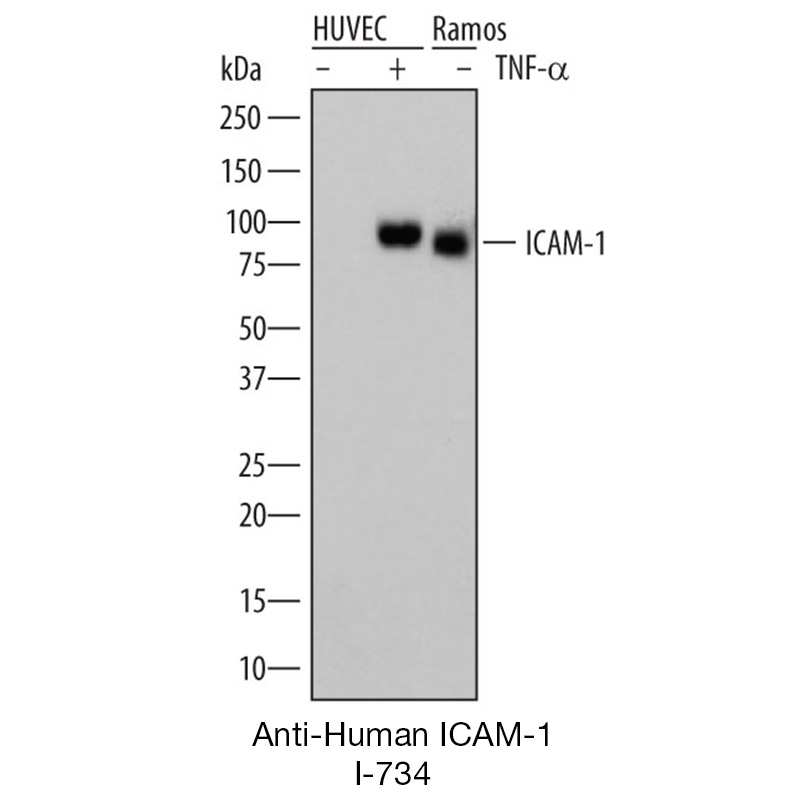Anti-Human ICAM-1
Data
- -
- -
Antibody DetailsProduct DetailsReactive Species Human Host Species Sheep Immunogen CHO Cell-Derived Recombinant Human ICAM-1 Extracellular Domain Endotoxin Level <0.2 EU/µg as determined by the LAL method Formulation This antigen affinity purified polyclonal antibody has been 0.2 µm filtered and lyophilized from modified Dulbecco’s phosphate buffered saline (1X PBS) pH 7.2 – 7.4 containing 5.0% w/v trehalose with no calcium, magnesium, or preservatives present. State of Matter Lyophilized Storage and Handling The lyophilized antigen affinity purified polyclonal antibody can be stored desiccated at -20°C to -70°C for twelve months from date of receipt. The reconstituted antibody can be stored for at least four weeks at 2-8°C. For long-term storage of the reconstituted antibody, aseptically aliquot into working volumes and store at -20°C to -70°C in a manual defrost freezer. Avoid Repeated Freeze Thaw Cycles. No detectable loss of activity was observed after six months. Country of Origin USA Shipping Next Day Ambient RRIDAB_2830855 Applications and Recommended Usage? Quality Tested by Leinco Western Blotting: To detect Human ICAM-1 this polyclonal antibody can be used at a concentration of 0.1 - 0.2 µg/ml. This polyclonal antibody should be used in conjunction with compatible second-step reagents. The detection limit for Human ICAM-1 is 2 ng/lane under either reducing or non-reducing conditions. The sensitivity of detection may increase up to 50 fold when a chemiluminescent substrate is used. Additional Applications Reported In Literature ? Immunocytochemistry: Suitable for use at concentration of 1-15 µg/mL. Blocking: The adhesion of HSB2 human peripheral blood acute lymphoblastic leukemia cells (5 x 104 cells/well) to immobilized recombinant human ICAM-1/Fc Chimera (12.5 μg/mL, 100 µL/well) was maximally inhibited (80‑100%) by 25 μg/mL of the antibody. Each investigator should determine their own optimal working dilution for specific applications. See directions on lot specific datasheets, as information may periodically change. DescriptionDescriptionSpecificity Sheep Anti-Human Intercellular Adhesion Molecule 1 (ICAM-1) recognizes Human ICAM-1. This antigen affinity purified polyclonal antibody was purified using a proprietary chromatographic technique that includes covalently immobilizing the antigen proteins or peptides to agarose based beads. This purification method enhances specificity, reduces nonspecific binding of extraneous IgG and provides you with the most reliable reagent available for your early discovery research. Background ICAM-1 is a 55 kDa glycoprotein that is part of the Ig superfamily. It is heavily glycosylated to form 75 kDa to 115 kDa. ICAM-1 is known to be an adhesion and viral entry molecule, and its long suspected involevement in signal transduction is being elucidated. The signal-transducing functions of ICAM-1 appear to be mainly associated with proinflammatory pathways. Furthermore, ICAM-1 signaling appears to act as a beacon for inflammatory immune cells such as macrophages and granulocytes bringing about inflammation via lymphocyte trafficking. ICAM-1 is essential for the transmigration of leukocytes out of blood vessels and into tissues, and is a marker of endothelial dysfunction leading to damaging vascular disorders in umbilical and placental vascular tissue of gestational pregnancies. ICAM-1 is the receptor for rhinoviruses (the cause of most common colds) and malaria, and plays an inflammatory role in ocular allergies. Antigen Distribution CD54 is present on endothelial cells, lymphocytes, epithelial cells, dendritic cells and keratinocytes. PubMed NCBI Gene Bank ID References & Citations1. Li, S. et al. (2009) Biochem Biophys Res Commun. 381: 459 2. Wolf, S. et al. (2009) Pharmacol Rep 61: 22 3. Ozcan, U. et al. (2009) Arch Gynecol Obstet. Technical ProtocolsCertificate of Analysis |
Related Products
- -
- -
Prod No. | Description |
|---|---|
I-682 | |
I-727 | |
I-734 | |
I-741 | |
I-580 | |
I-587 | |
I-571 | |
I-786 | |
I-794 |



